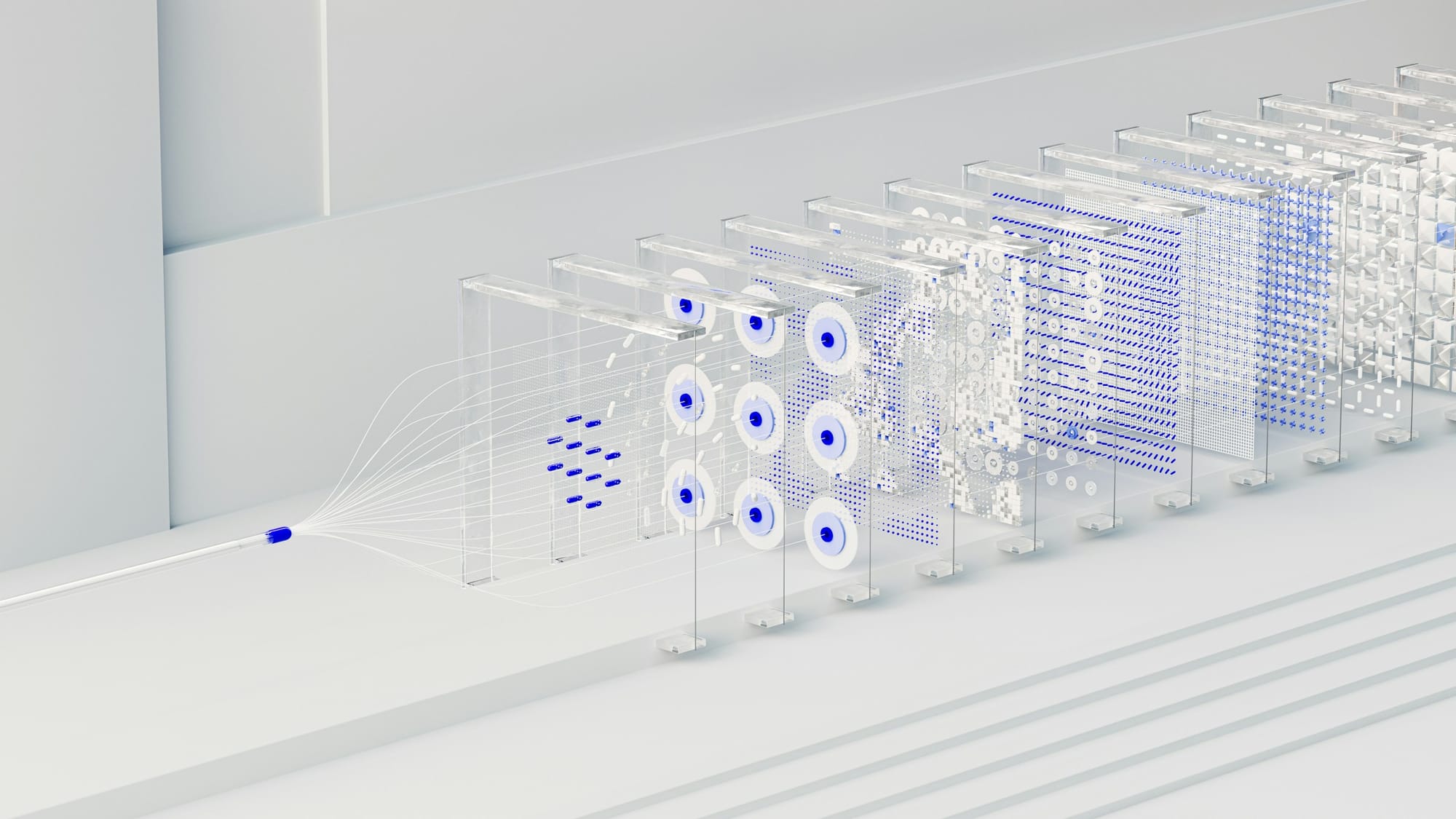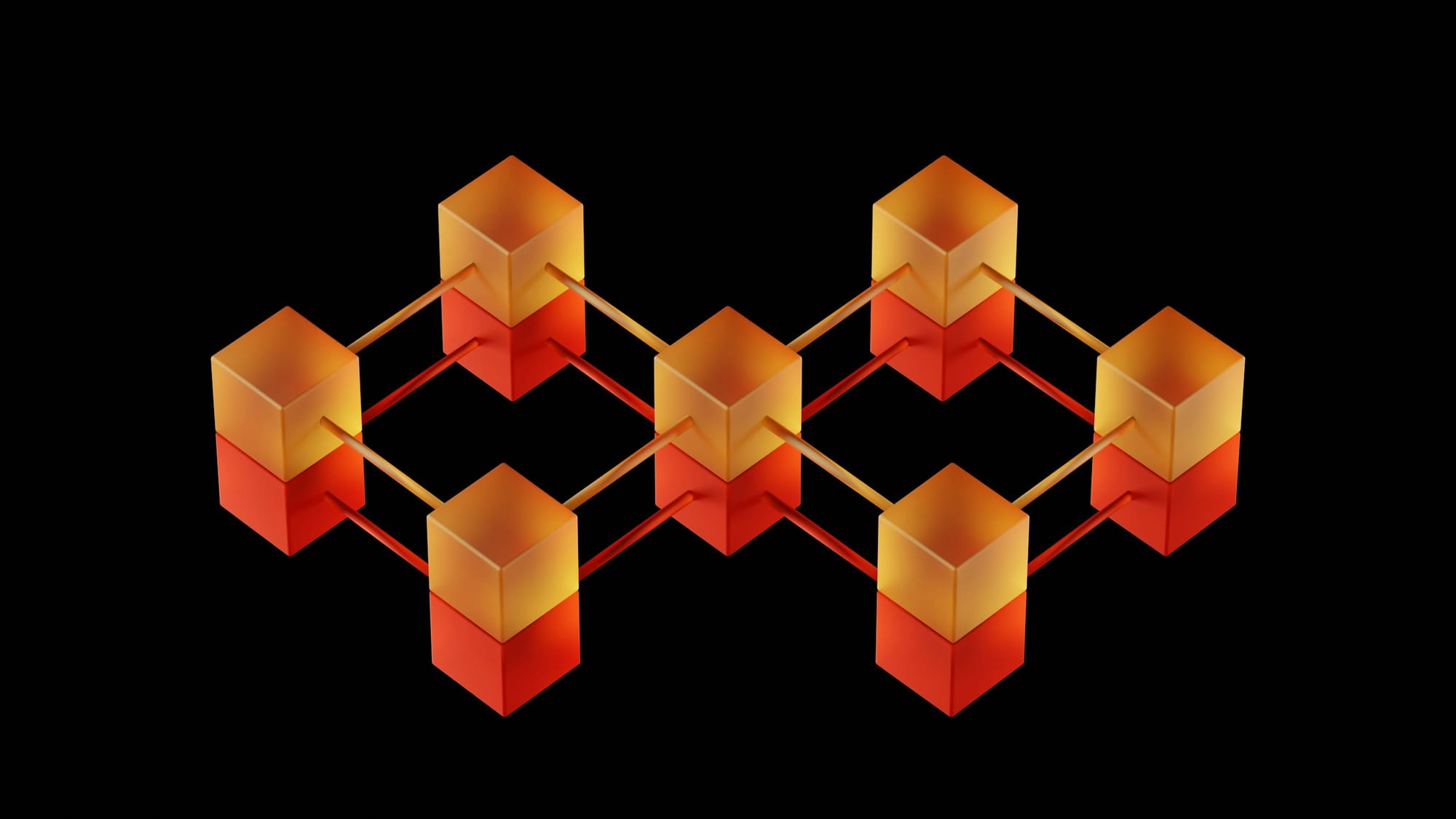As businesses increasingly adopt AI tools, they often encounter a familiar obstacle: effectively integrating these capabilities into their existing applications. AI middleware offers a solution. This software can streamline your operations, improve system performance, and enhance the user experience by acting as a bridge between your current systems and AI models. This article will explore the significance of AI middleware, focusing on the benefits it can offer your organization and how to pick the right solution for your needs.
Lamatic's generative AI tech stack provides an easy-to-implement AI middleware solution to help you seamlessly integrate AI into your applications. This solution can improve performance, increase scalability, and enhance efficiency while simplifying the integration process.
What Is AI Middleware?

AI middleware acts as a bridge between applications and AI models or services, simplifying the integration of AI capabilities into existing systems. AI middleware, also called AI orchestration or AI integration software, provides a pipeline for moving data efficiently from its sources to AI systems that analyze and infer and then automate systems that act.
In industrial environments, AI middleware connects data to AI models and automation. In this context, an AI model uses past data to interpret and make inferences about current events or predict future occurrences. Training data includes:
- Production processes
- Machine tolerances
- Known failure mechanisms
- Photos of workers with and without hard hats
“Once the model sees enough examples, it can be given new data and, based on what it has already learned, the AI model provides an informed guess,” explains Seth Clark, co-founder and head of product at Modzy, a leading production platform for machine vision. “While the logic is complex internally, in an industrial setting, as long as the AI model provides reliably accurate predictions for that particular business, it’s a good model.”
Types of AI Middleware
As Clark explains, there are three types of AI middleware. These are AI accelerators,
model-serving middleware, and connectivity middleware. AI models often involve machine learning, which requires heavy-duty processing.
AI Accelerators optimize AI inference for specific hardware devices, including:
- NVIDIA TensorRT
- Intel OpenVINO
Model-serving middleware, by contrast, enables an AI model to receive input, process it, and return results.
AI connectivity middleware facilitates data flow to and from AI models by using:
- APIs
- Software development kits (SDKs)
- Internet protocols
This enables the AI model to deliver results to systems capable of acting on them, such as:
- Ventilation system
- Robotic control system
- Operations center
Who Uses AI Middleware?
Clark adds that those interacting with it broadly distinguish AI middleware from AI software. Business users and industrial workers use AI software applications to do their jobs more productively and effectively.
In contrast, AI middleware operates behind the scenes, providing connectivity for:
- Automation engineers
- Supply chain teams and IT
- Operational technology (OT) operators
“AI software is like the cell phone and AI middleware is like the 5G mobile network,” Clark explains. “Both are essential for an effective AI solution.”
Cost and Flexibility of AI Middleware
Sources of AI middleware affect cost and flexibility. Closed- and open-source libraries are two sources of AI middleware, each with pros and cons.
“Open-source AI software, such as TensorFlow, Open Computer Vision Library (OpenCV) and PyTorch, requires more expertise for effective use than closed-source AI libraries but is more powerful and free to use,” says Peter McLaughlin, cofounder of Agmanic Vision, an expert provider of computer vision solutions. “This can mean higher initial development costs, but lower licensing costs and greater flexibility over the long term.”
In contrast, closed-source AI middleware libraries from companies, such as Halcon and Matrox Imaging, charge licensing fees but provide higher-level functionality and can be more convenient for developers to use than building a solution from the ground up.
As McLaughlin adds, vendors that produce a product that contains AI middleware must factor other considerations into their decision to use open- vs. closed-source components:
- Product support
- Future development
“The lack of visibility and control over closed-source middleware could impact their ability to support their customers and develop new products,” he says.
Getting Down to Business with AI Middleware
Deploying an AI model in real-world settings, such as on a factory floor, on a robot, or in the field, requires significant integration of IT systems and industrial Internet of Things (IIoT) devices. These systems generate inputs for the model and utilize its outputs. For instance, a computer vision application needs:
- Cameras
- Lenses
- Lighting
- Brackets
- Electrical panels
A system to process and use the information generated by the model. “When creating an inspection system, for example, you also need a way to feed and present the part to the camera,” McLaughlin says. “Then, to use the AI’s output, you need a reject mechanism that takes results from the AI model and uses them to separate bad parts from good parts.”
Outsourcing Expertise for Seamless Integration
As McLaughlin explains, expertise is crucial to solving integration challenges, but it does not need to reside in-house. “For any industrial AI solution, I recommend that project managers reserve time in the timeline to bring in an expert from the solution vendor or an external consultancy,” he says. “While much industrial AI innovation occurs in Fortune 500 companies that have software architects on staff, solution providers like Agmanic Vision help businesses of all sizes to create highly integrated, end-to-end AI vision and robotics solutions.”
AI Middleware Use Cases
The key to finding a good AI project is to identify a costly business problem that cannot be solved by traditional automation but by smart automation that learns from examples and makes a judgment call. Following are accounts of recent projects delivered by AI middleware vendors Agmanic Vision, Modzy, and Numurus, respectively, that addressed common challenges on the factory floor and in a mobile setting.
Effective and Efficient Defect Detection and Sorting
On the factory floor, one customer wanted to automate the detection of cracks in inexpensive grinding disks. Still, traditional automation did not work because the disk surface was reflective, and the disks varied from one to the next with wide tolerances.
“An AI solution created by Agmanic Vision enabled the customer to identify even the tiniest cracks more effectively than they could using a human worker,” McLaughlin says.
Another Agmanic Vision project involved a paper mill that produced diaper material. A blunt or broken blade failed to perforate a roll, causing problems that might show up days or even weeks later when processed by downstream equipment.
The AI solution integrated mechanical, software, and electrical systems to produce a system that immediately scans a roll to identify incomplete perforation. “The solution stopped production when it detected a defect, vastly reducing the amount of scrap produced,” McLaughlin said. “Consequently, it paid for itself in just a few months.”
Maintaining Industrial Safety
Another factory-floor project, this one addressed by Modzy, resolved a potentially serious safety issue. The US Occupational Safety and Health Administration (OSHA) flagged a build-up of noxious fumes that put workers at risk in one production plant area.
“Using a predictive AI model, Modzy created and implemented a predictive air-monitoring solution that processed air-sensor data and took action to maintain or restore air quality,” Clark explains. “This included alerting workers hours in advance of a likely build-up and gave them the ability to open doors and turn on industrial ventilation fans.”
Fast-Tracking Mobile AI Development
AI middleware also solves industrial challenges far from the factory floor. To address one such challenge on the ocean, Numurus helped to develop an AI solution for a vendor of commercial-fishing sonar systems for use with large nets.
“To stay competitive, this vendor, like other sensor vendors, needed to modernize a 15-year-old product,” Seawall explains.
Leveraging AI for Innovative Solutions in the Fishing Industry
Working with Numurus and a team of two engineers, the sonar vendor quickly brought to market an AI-enabled system and smartphone app that made it easier for their customers to find and catch more fish. The connectivity and model acceleration AI middleware makes simple and complex industrial processes smarter. When business problems stymie traditional automation, industrial companies may consider AI.
AI Middleware vs API: What’s the Difference?
Although middleware and APIs can communicate between software components, their functions are distinct. Middleware is a mediator that enables applications to communicate and integrate; APIs offer set interfaces to access some functionality or data in an application or service.
Related Reading
- Gen AI vs AI
- GenAI Applications
- Generative AI Customer Experience
- Generative AI Automation
- Generative AI Risks
- How to Create an AI App
- AI Product Development
- GenAI Tools
- Enterprise Generative AI Tools
- Generative AI Development Services
Evolution of GenAI Middleware Architecture

AI Middleware architectures started simple, with the early systems relying on message passing to connect disparate applications. These solutions often helped improve heterogeneity across different systems. As computing environments became more complex, research and development focused on enabling middleware to function in dynamic environments and to improve:
- Performance
- Scalability
- Security
- Dependability
The emergence of Generative AI has opened up a new dimension of middleware architecture. GenAI middleware enhances traditional functionalities with intelligent decision-making and autonomous operation, enabling adaptive behavior in complex systems.
The Rise of GenAI Middleware
GenAI middleware is a new breed of intelligent software solutions that improve interactions across distributed systems. They enhance traditional middleware operations by incorporating:
- Intelligent data processing
- Adaptive resource management
- Improved communication protocols
These capabilities allow GenAI systems to reduce human intervention, improve performance, and enhance security and privacy in distributed computing environments.
Intelligent Data Processing
GenAI middleware improves traditional data processing capabilities by incorporating machine learning and natural language processing techniques. This enables real-time analysis of large volumes of data to extract valuable insights and patterns that can be used in decision-making. By using context clues and user preferences, GenAI middleware dynamically processes or prioritizes data to respond to changing conditions and requirements.
Adaptive Resource Management
GenAI middleware dynamically manages resources in distributed computing environments to improve efficiency. It analyzes system metrics and user interactions to distribute computing resources intelligently, balance workloads across nodes, and address performance bottlenecks. This capability promotes smooth operations to enhance performance and ensure reliable service delivery.
Enhanced Communication Protocols
GenAI middleware improves communication protocols by integrating:
- Natural language understanding
- Semantic interoperability
- Context-aware messaging
By applying natural language processing capabilities, GenAI middleware facilitates intuitive interactions between human users and intelligent systems to reduce barriers to communication. This enables seamless collaboration across distributed computing environments, enhancing information sharing and decision-making.
Autonomous Decision-Making
GenAI middleware can make independent decisions based on learned knowledge and contextual information. The systems apply machine learning algorithms to:
- Study data
- Learn from past experiences
- Determine how to achieve set goals
This capability enables GenAI middleware to operate autonomously, adapt to unpredictable events, and maintain peak performance under various conditions without human control or manual intervention.
Scalability and Extensibility
GenAI middleware is highly scalable and extensible, allowing for quick adjustments to changing requirements. The systems can seamlessly expand capacity to handle increasing workloads and user demand. Typically modular, GenAI middleware enables developers to add easily:
- New components
- Algorithms
- Functionalities as needed
This allows the systems to support any application regardless of size.
Security and Privacy
Security and privacy are crucial design considerations for GenAI middleware. Intelligent systems operate on sensitive data and perform critical tasks, so maintaining high availability, data integrity, and confidentiality is essential.
GenAI middleware systems incorporate robust security mechanisms to protect sensitive information, such as:
- Encryption methods
- Strict access controls
The platforms also support privacy-preserving techniques like federated learning and differential privacy to minimize data sharing and processing risks.
Continuous Learning and Improvement
GenAI middleware supports continuous learning and improvement using:
- Feedback loops
- Adaptive algorithms
- Self-monitoring mechanisms
By learning from past experiences, user interactions, and environmental feedback, GenAI systems enhance performance levels over time by improving middleware's decisions or adapting to changing conditions. This capability ensures GenAI service desk systems remain relevant in ever-changing computing environments for long-term viability and sustainability.
Related Reading
- Gen AI Architecture
- Generative AI Implementation
- Gen AI Platforms
- Generative AI Challenges
- Generative AI Providers
- How to Train a Generative AI Model
- Generative AI Infrastructure
- Top AI Cloud Business Management Platform Tools
- AI Frameworks
- AI Tech Stack
11 Leading AI Middleware Providers
1. Lamatic: Simplifying Generative AI Integration for Teams

Lamatic offers a managed generative AI tech stack. Our solution provides:
- Managed GenAI Middleware
- Custom GenAI API (GraphQL)
- Low Code Agent Builder
- Automated GenAI Workflow (CI/CD)
- GenOps (DevOps for GenAI)
- Edge deployment via Cloudflare workers
- Integrated Vector Database (Weaviate)
Lamatic empowers teams to rapidly implement GenAI solutions without accruing tech debt. Our platform automates workflows and ensures production-grade deployment on the edge, enabling fast, efficient GenAI integration for products needing swift AI capabilities.
Start building GenAI apps for free today with our managed generative AI tech stack.
2. TensorFlow Serving: The Top Choice for Serving ML Models

TensorFlow is an open-source platform for creating and training deep learning models. Developed by Google, it is popular across industries such as:
- Healthcare
- Finance
- Transportation
TensorFlow offers many machine learning algorithms, including neural networks for complex predictive analytics. Its versatility and community support make it ideal for developers and businesses looking to harness the power of deep learning and AI.
3. Apache MXNet: A Scalable Deep Learning Framework

Apache MXNet is a scalable deep-learning framework supporting symbolic and imperative programming. It is mainly known for its efficiency in training deep neural networks. Key features include:
- Gluon API: Provides a clear and simple interface for building neural networks.
- Multi-language Support: Compatible with Python, Scala, and R, among others.
- Performance Optimization: Designed for high performance on both CPUs and GPUs.
4. Microsoft Azure AI: A Robust Cloud-Based AI Platform

Microsoft Azure Machine Learning is a cloud-based advanced analytics and artificial intelligence platform designed to simplify machine learning for businesses. It provides businesses with essential AI services and tools, enabling efficient strategy building, deployment, and management.
These solutions include:
- Machine learning
- Deep learningCognitive benefits
With support for popular frameworks like TensorFlow, PyTorch, and Python, pre-built APIs for intelligent features, and a range of machine learning models, Azure Machine Learning ensures reliability and ease of use for businesses.
5. Amazon SageMaker: Managed ML Model Services

Amazon SageMaker is a fully managed service that provides tools for building, training, and deploying machine learning models. It serves as middleware by simplifying the integration of AI into applications.
6. IBM Watson: AI for Business

IBM Watson is an AI platform that uses human intelligence and enables businesses to:
- Automate complex machine-learning processes
- Predict future results
- Maximize employee productivity
With its powerful AI algorithms, Watson can analyze vast amounts of data and provide valuable insights for various industries, such as:
- Healthcare
- Finance
- Marketing
- Customer service
It offers features like:
- Natural language processing
- Machine learning
- Knowledge representation
This ensures businesses can leverage AI's power to gain a competitive edge. IBM Watson's pricing model includes a free Lite plan, a Plus plan at $140 per month, and a customizable enterprise plan.
7. Google Cloud AI Platform: Comprehensive AI Software

The Google AI Platform is a comprehensive AI software platform with built-in algorithms for tasks like:
- Image recognition
- Natural language processing
It offers a range of pre-trained cloud APIs for building machine learning applications related to:
- Computer vision
- Translation
- Natural language
- More on the Google Cloud AI Platform
Google Assistant, for instance, is one of the impressive AI voice generators available on this cloud platform. Google Cloud AI Platform caters to the diverse needs of businesses with customized options for training models, and support for popular AI technology frameworks like:
- PyTorch
- TensorFlow
- Scikit-learn
- A pay-per-use pricing model
8. RapidMiner: Data Science Platform Serving as Middleware

RapidMiner is a data science platform that can serve as middleware by providing tools for:
- Data preparation
- Machine learning
- Model deployment
This enables easier integration into business processes.
9. H2O.ai: Open-Source Flexibility for AI

H2O.ai is an open-source machine learning platform that offers various solutions for diverse industries, including:
- Digital advertising
- Claims management
- Fraud detection
- Advanced analytics
It supports various types of data, such as:
- Tabular
- Text
- Image
- Audio
- Video
This enables businesses to harness the power of machine learning for their specific needs. With a 90-day free trial and a pay-per-feature pricing model, H2O.ai provides a flexible and accessible solution for businesses leveraging AI capabilities.
10. PyTorch: A Flexible, Open-Source Framework

PyTorch, developed by Facebook, is another popular open-source machine learning framework. It is known for its dynamic computation graph, allowing more flexibility in model building. Key features include:
- TorchScript: A way to create serializable and optimizable models from PyTorch code.
- Distributed Training: Simplifies the process of training models across multiple GPUs.
- Rich Ecosystem: Includes libraries like torchvision for computer vision tasks.
11. Keras: Simplifying Neural Network Development

Keras is a high-level neural networks API that runs on top of TensorFlow. It is designed to enable fast experimentation with deep neural networks.
Key features include:
- User-friendly API: Simplifies the process of building and training models.
- Modular and Composable: Allows for easy configuration of neural network layers.
- Support for Multiple Backends: Can run on TensorFlow, Theano, or CNTK.
What Are the GenAI Middleware Implementation Strategies?

Assessing Needs and Analyzing Requirements
Before implementing GenAI middleware, an organization should perform a needs assessment and requirements analysis to identify specific:
- Use cases
- Business objectives
- Technical requirements
This involves engaging all corporate stakeholders, obtaining user feedback, and evaluating existing infrastructure and systems.
Smooth Integration with Existing Systems
To ensure compatibility, GenAI middleware needs to integrate seamlessly with existing organizational:
- Systems
- Applications
- Infrastructures
Stakeholders should carefully evaluate several key factors to enable smooth interaction between GenAI middleware and other elements in the computing environment, including:
- Points of integration
- Communication protocols
- Data exchange mechanisms
These considerations help ensure seamless interoperability and adequate data flow across systems. To enable uninterrupted data flow between multiple, potentially incompatible systems, the following may assist in this process:
- APIs
- Standards-based interfaces
- Middleware connectors
Choosing Development Frameworks and Tools
Selecting the right development frameworks and tools is crucial in building and deploying GenAI middleware solutions effectively. Organizations should use modern software development platforms, AI frameworks, and middleware technologies that support rapid prototyping, experimentation, and scalability.
Open-source frameworks can be utilized to develop and deploy GenAI middleware applications in various computing environments, including:
- TensorFlow
- PyTorch
- Apache Kafka
Focus on Model Training and Optimization
Intelligent data processing and decision-making tasks use machine learning models and algorithms with GenAI middleware. Organizations should invest time and resources in the following areas to ensure accuracy, efficiency, and performance of machine learning models:
- Training
- Fine-tuning
- Optimizing
These efforts are crucial for achieving the best results from machine learning initiatives. Techniques like hyperparameter tuning, model compression, or transfer learning can make GenAI middleware solutions more effective and scalable.
Prioritize Scalability and Performance Testing
GenAI middleware must focus on scalability and performance testing, particularly in large-scale distributed computing environments. Organizations should conduct thorough tests and benchmarks to measure the scalability, throughput, and latency of GenAI middleware solutions under different workloads or conditions. Common ways of identifying bottlenecks include:
- Load testing
- Stress testing
- Performance profiling
These methods optimize resource utilization while ensuring that GenAI middleware is reliable in production.
Address Security and Compliance Issues
Given the nature of data managed by intelligent systems, security, and compliance are critical in implementing GenAI middleware. To avoid breaches or unnecessary risks, firms should implement proper security measures, such as:
- Encryption methodologies
- Access controls
Adhering to relevant laws and regulations is essential for maintaining security and compliance. They must maintain regular security audits and vulnerability assessments to uncover and mitigate risks associated with deploying GenAI middleware.
Develop Information and Skills
To successfully deploy GenAI middleware, skilled personnel in AI, ML, middleware architecture, and distributed computing are needed. Organizations should invest in training and skill development programs to ensure employees have the knowledge and ability to design, develop, install, and maintain GenAI middleware solutions effectively.
Cross-functional collaboration and knowledge sharing, including continuous learning initiatives, nurture a culture of innovation towards implementing GenAI middleware.
Track and Improve Solutions Over Time
GenAI middleware solutions require constant tracking to work optimally after deployment, as well as optimization and maintenance for reliability. Organizations should deploy monitoring tools to track system metrics and address real-time challenges, including:
- Logging mechanisms
- Alerting systems
These tools help detect anomalies and facilitate troubleshooting. Continuous optimization comprises performance tuning or software updates, increasing the value of any GenAI middleware deployments over time.
Related Reading
- AI Application Development
- Best AI App Builder
- AI Development Platforms
- AI Development Cost
- SageMaker Alternatives
- Gemini Alternatives
- LangChain Alternatives
- Flowise AI
Start Building GenAI Apps for Free Today with Our Managed Generative AI Tech Stack
Lamatic offers a managed Generative AI Tech Stack solution. Our platform provides Managed GenAI Middleware and ensures rapid implementation of Generative AI solutions with minimal technical debt. Start building GenAI apps for free today with our managed generative AI tech stack.
Automated GenAI Workflows With CI/CD
Our platform includes Automated GenAI Workflows (CI/CD) that simplify and speed up Generative AI app development. With Lamatic, teams can stress less about the complexities of developing Generative AI applications and focus on building features that deliver end-user value.
GenOps: DevOps For Generative AI
GenOps is a term for the practices and processes that enable smooth and efficient development and deployment of Generative AI applications. Lamatic’s GenOps features empower teams to develop and deploy Generative AI applications that are production-ready and don’t accrue tech debt.
Integrated Vector Database for Generative AI
Lamatic’s managed Generative AI tech stack includes an integrated Vector Database (Weaviate) that is optimized for storing and retrieving the data used by AI applications. This makes it easier for teams to build AI apps that perform well and deliver valuable results to end users.
Low Code Builder for Generative AI Agents
Lamatic includes a low code interface for building Generative AI agents or applications. This interface provides customizable templates that make it easier for teams to create and deploy AI agents that meet their unique needs.





